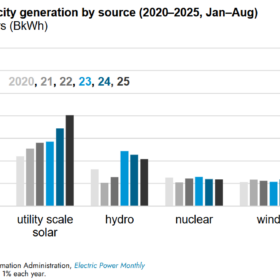The U.S. military’s emissions are greater than many countries, its twelve-digit annual expenditures greater than most countries, and it is the largest energy user in the United States. It is also a huge investor in advanced energy research, a significantly growing user of renewables, and per the U.S. Department of Energy the Defense Department has seen energy usage fall almost 50% since 1975.
U.S. Senator and Presidential Candidate Elizabeth Warren (D-Massachusetts), and Representative Veronica Escobar (D), have introduced the Department of Defense Climate Resiliency and Readiness Act (pdf). The broader purpose of the document (section by section summary – pdf) is to use to heft of the military to drive clean energy adoption, while also readying the U.S. Military for future environmental shifts that will affect readiness.
The meat of the legislation requires the Defense of Department (DoD) to achieve net zero energy, in the aggregate, by ‘non-operational’ (fixed military infrastructure not supporting combat operations, or combat vehicles) assets globally by 2030. Within a year, a written strategy to meet this goal must be submitted, and every two years thereafter a progress report on meeting said goals must be submitted.
The document also makes quickly escalating appropriations for the research, development, and demonstration programs for microgrids and electric grid energy storage of:
- 2020 – $10 million
- 2021 – $25 million
- 2022 – $50 million
- 2023 – $75 million
- 2024 – $125 million
- 2025 – $200 million
- 2026-2030 – $250 million annually
The microgrid R&D program must prioritize integrating renewable energy sources, such as wind, solar, and hydropower; additive manufacturing; energy storage; location generation of zero-carbon fuels; developing and using fuel-efficient engines; empirical and science-based industry standards – within a broader umbrella of increasing the DoD’s readiness.
Planning, budgeting, procurement, and reporting processes dominate the rest of the document.
The annual DoD budget would be required to include, “a stream of dedicated funds for adapting to, and mitigating, climate change related risks to military networks, systems, installations, facilities, and other assets and capabilities.” It would also be required that the DoD report the effects on military readiness and an estimate of the financial costs reasonably attributed to climate change-related events over the preceding year, such as DoD actions to mitigate the effects of:
- Extreme weather
- Rising sea tides
- Increased flooding
- Drought
- Desertification
- Wildfires
- Thawing permafrost
Annually, the DoD will be required to list the ten military bases within each service that emit the most carbon, an estimate of all energy consumption by the Defense Department, including greenhouse gas emissions, and an assessment of greenhouse gas emissions at all military bases, separated by operational sources and non-operational sources.
Contractors working with the DoD will also be required to report on their emissions, their climate risks, whether or not they are net zero, and – if not – then those contractors must pay a 1% fee on their bids which will be pooled into a newly created Energy and Climate Resiliency Fund which can only be used for improvements that adapt military networks, systems, installations, facilities, and other assets and capabilities to climate change.
This content is protected by copyright and may not be reused. If you want to cooperate with us and would like to reuse some of our content, please contact: editors@pv-magazine.com.








By submitting this form you agree to pv magazine using your data for the purposes of publishing your comment.
Your personal data will only be disclosed or otherwise transmitted to third parties for the purposes of spam filtering or if this is necessary for technical maintenance of the website. Any other transfer to third parties will not take place unless this is justified on the basis of applicable data protection regulations or if pv magazine is legally obliged to do so.
You may revoke this consent at any time with effect for the future, in which case your personal data will be deleted immediately. Otherwise, your data will be deleted if pv magazine has processed your request or the purpose of data storage is fulfilled.
Further information on data privacy can be found in our Data Protection Policy.